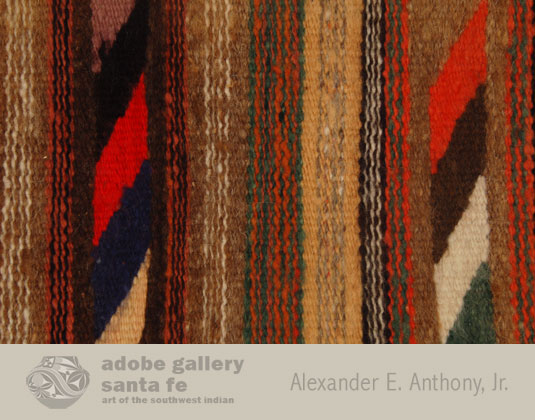Navajo Chinle-style Navajo Banded Textile [SOLD]
+ Add to my watchlist Forward to Friend
- Category: Navajo Textiles
- Origin: Diné of the Navajo Nation
- Medium: wool, dye
- Size: 23-¾” x 16-¾”
- Item # C4076E SOLD
Lorenzo Hubbell, a well-known name among Indian traders, operated the trading post in Chinle, Arizona, as early at 1917. Chinle is at the mouth of Canyon de Chelly. Because of his trading post at Ganado, Arizona, Hubbell had the weavers at Chinle weave similar styles to ones being woven at Ganado. Hubbell eventually sold out to Cozy McSparron who, with the support of Mary Cabot Wheelwright, an enthusiast of Native American art, from Boston, introduced changes at Chinle. Wheelwright objected to the Ganado style of patterns and sought to return to nineteenth-century Classic blanket styles and natural colors. She had photographs of Classic Navajo blankets sent to the trading post for McSparron to share with weavers.
To encourage the transition to Classic style weaving, Wheelwright supplied funds to purchase the weavers’ initial efforts, regardless of quality or outcome, to encourage them to continue in the effort. Eventually, the banded style of natural colors was accepted by the weavers at Chinle and by the visitors to the trading post who purchased their rugs.
The Chinle distinctive palette evolved with the use of dyes from native plants, resulting in rugs of white, black, yellows and browns, devoid of any commercial dyes. Eventually, Mrs. Wheelwright asked the DuPont Company to develop some muted, natural-looking colors, in an effort to achieve the softness of colors derived from plants. The McSparron/Wheelwright efforts were successful and banded, natural-color textiles became standard products from Chinle Trading Post. The Chinle style was adopted by the Lippincotts, who bought the Trading Post at Wide Ruins in 1938, and eventually spread to Crystal Trading Post by the 1940s, replacing the famous J. B. Moore patterns that had been woven up to that time. Today, the Chinle Revival style may be found all over the Navajo Nation.
The small banded textile illustrates the banded pattern of Chinle with some modifications by this weaver in adding bands of brighter-colored rectangles. This is a later textile, probably from the mid-20th century.
Condition: this Navajo Chinle-style Navajo Banded Textile is in very good condition
Provenance: from the estate of a Native American artist
Reference: Old Navajo Rugs: Their Development from 1900 to 1940 by Marian E. Rodee

- Category: Navajo Textiles
- Origin: Diné of the Navajo Nation
- Medium: wool, dye
- Size: 23-¾” x 16-¾”
- Item # C4076E SOLD



